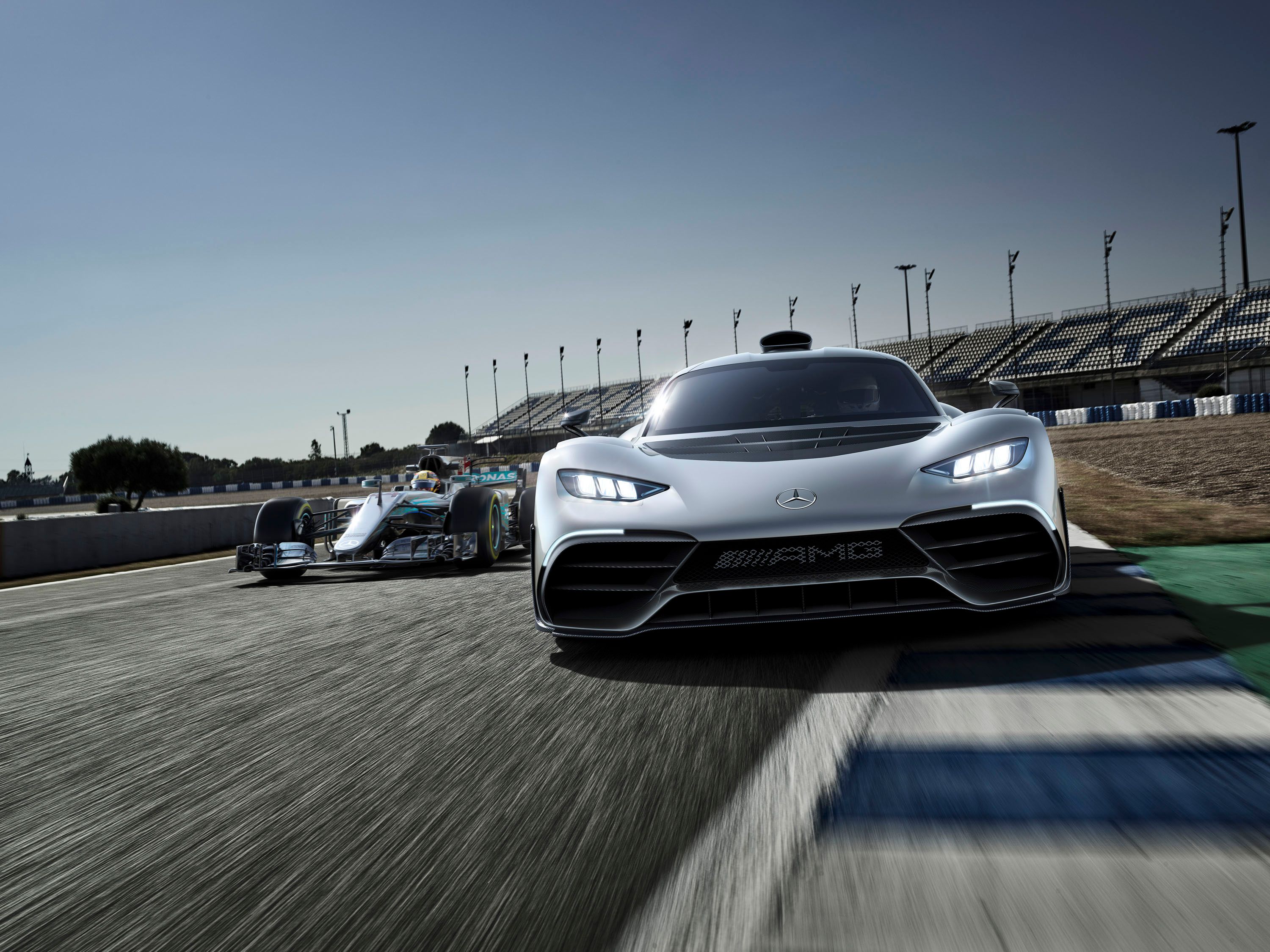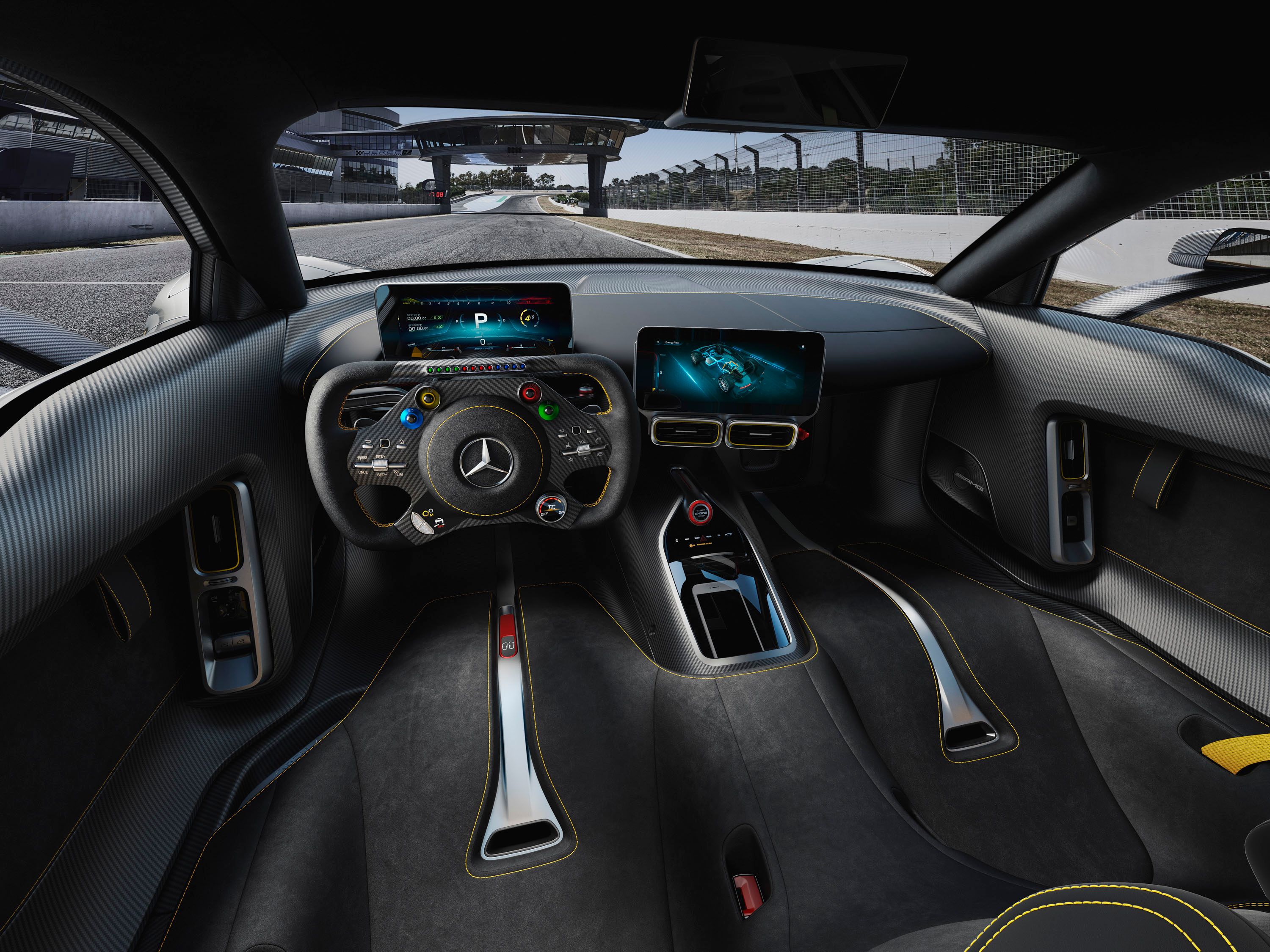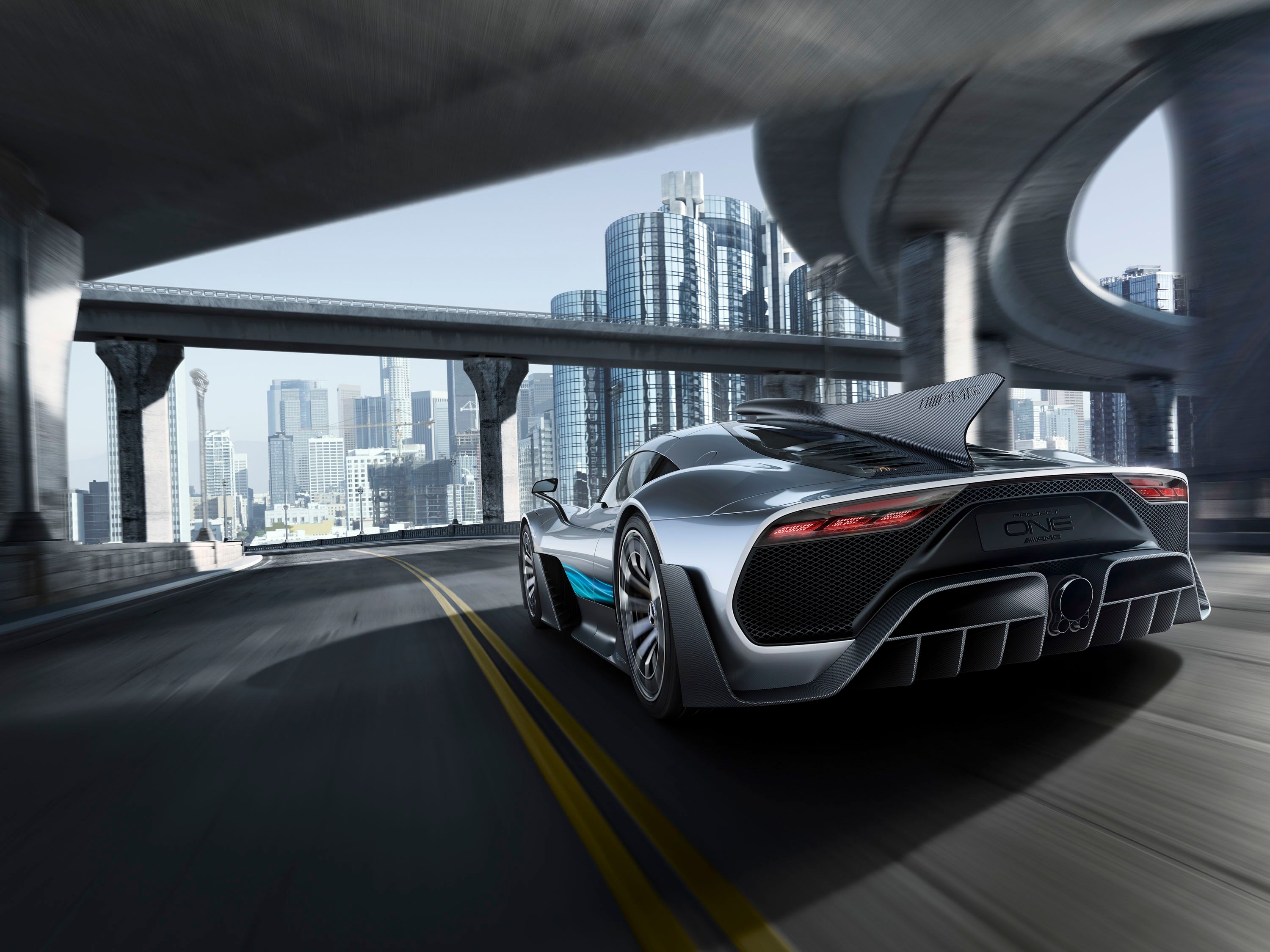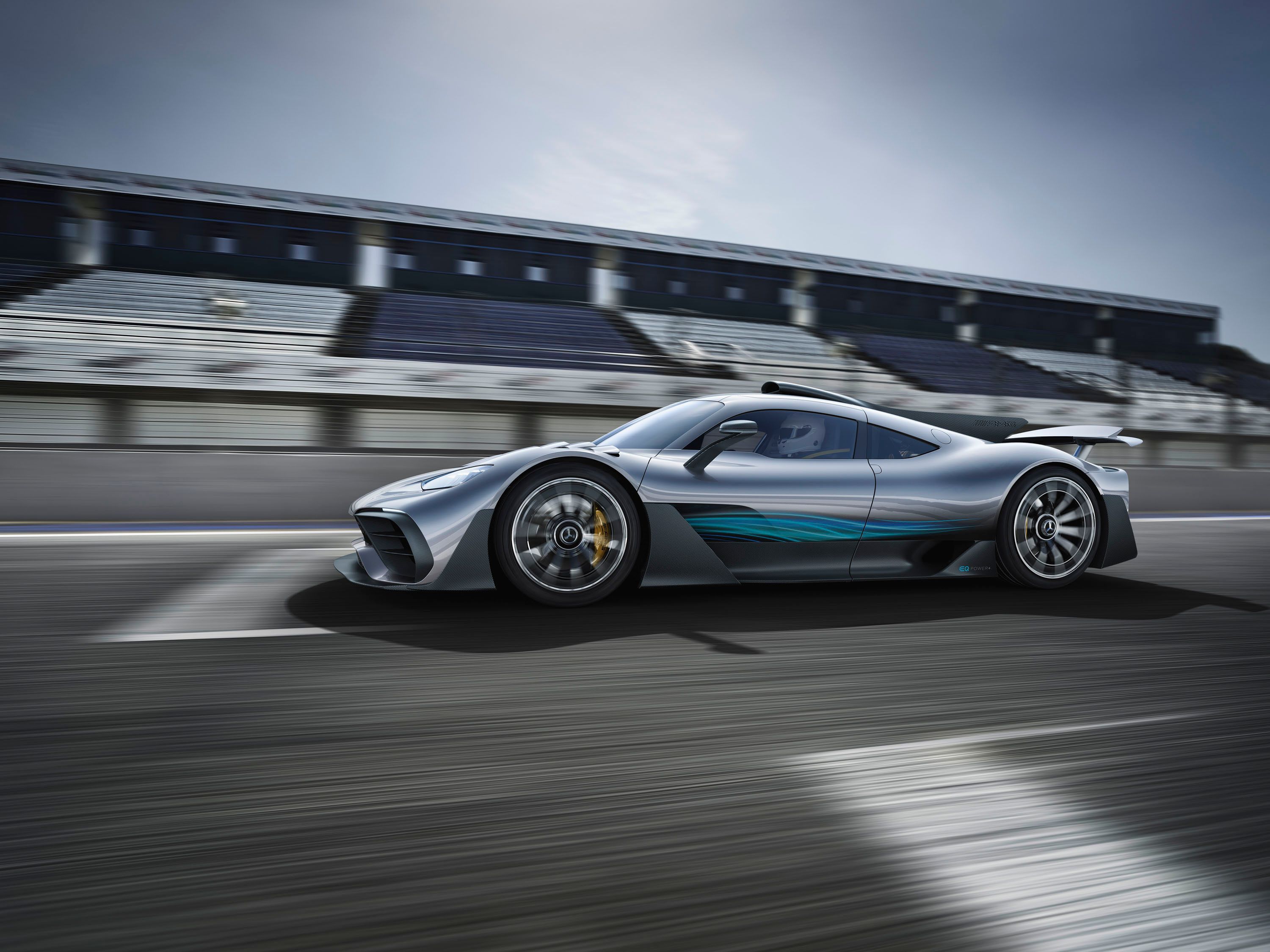The Mercedes-AMG Project One is here, and the first thing that comes to mind for me is that Mercedes really needs to quit playing with people’s emotions. Under the metal, you’ll find a 1.6-liter V-6 that features a unique setup straight from Formula One. It features a single turbo charger that is assisted by an electric motor to go with another electric motor in the crankcase and two motors at the front axle. The motor inside the turbocharger (not sure how that’s going to stand up to the excessive heat of the exhaust) spools up the turbo while the electric motor attached to the crankshaft via a spur gear. It delivers as much as 120 kW of power while the turbo charger is spooled by a 90kW motor. The engine sits in the middle of the vehicle, just ahead of the rear axle, and can handle speeds as high as 11,000 rpm. This is made possible by pneumatic valve springs instead of the typical mechanical springs. Meanwhile, the motors on the front wheels drive each wheel individually and can reach speeds as high as 50,000 rpm – 30,000 more than cure “state of the art technology.” All told, the Project One promises a system output of over 1,000 horsepower and a top speed “beyond” 217 mph all from that tiny engine and four electric motors.
The battery system itself is an 800-volt system, so that’s double the usual voltage associated with plug-in hybrids, is stored in the floorboard just behind the front axle. The actual capacity of the battery is unknown at this time, but Mercedes promises that maximum acceleration will get you up to 112 mph in “under six seconds” thanks to the electric motors and V-6 engine. Shifting duties are handled by an automated, eight-speed manual transmission that is said to have been developed from scratch for the Project one. It can shift itself or be shifted by the paddles ahead of the steering wheel. So, with that in mind, it’s basically an automatic transmission so don’t let the previous wording fool you – there’s no clutch pedal here. The onboard electrics are powered by that massive lithium-ion battery as well, but it is done by a converter that’s built into the battery system to prevent oversupply by the high-voltage system. There’s a lot more to this car than power output and performance, though, so let’s talk a little more about the exterior and interior design below.
Continue reading for the full story.
Beauty and the Beast? Hardly…
Mercedes has gone so far as to describe the Project One as “Beauty and the Beast.” Well, it’s only half right. Yeah, it’s certainly a beast, despite the fact that cars like the Bugatti Chiron, for example, can easily top that “more than 217 mph” top speed. The exterior design, on the other hand, is something else. To put it simply, the Project One looks better from behind. It’s like the girl next door that has an amazing ass but looks like she fell out of the ugly tree and hit every branch with her face on the way down. It’s clearly built to be aerodynamic and is based on Merc’s F1 technology, but this thing has a mouth like Momma June (that’s Honey BooBoo’s mom for those of you who don’t know) that is just way too big for a car like this.
Massive mirrors stick out from the sides like sky scrapers, but hey – at least it has a big, smooth booty. And, the air intake for the mid-mounted engine is just massive and looks so out of place. I’ve seen self-driving concepts with those big cameras up top that had better-looking roofs. I just hope those big corner intakes are actually used to cool the 800-volt battery and aren’t fake like every other car Mercedes produces.
Now that I’ve bashed the front end, which looks like someone saved the aborted bastard child between a McLaren P1 and a Porsche 918, let’s take a look at the back. Surprisingly, it’s pretty damn amazing back here. It’s attractive, muscular, and the massive central exhaust outlet is sure to give one hell of an exhaust note that turns heads and scares wildlife at the same time. The LED taillights blend in nicely with that massive black insert, and I love the styling of that ridiculously large rear diffuser. What I don’t get is the weird fish fin across the rear dead, which is ultimately part of the intake scoop for the engine. I mean I don’t know whether to eat it or throw it back in the water. All told, the exterior look may work for some, but I think Mercedes could have done much better with the front end. Let us know what you think after checking out the interior in the next section below.
Sometimes Beauty is on the Inside
Well, after wanting to kill the car before it lays eggs because of the front end design, I have to say the interior is quite impressive. First off, there’s more carbon fiber than expected with very little leather or Alcantara. The seats are built into the structure but offer reclining backrests while the steering wheel and pedals are adjustable so that the driver can find the optimal driving position. The steering wheel is clearing derived from F1, featuring a simpler button array and the typical rectangular look. A 10-inch display sits ahead of the driver and above the steering wheel to provide all of the pertinent information while allowing the driver to look ahead at all times – definitely a good idea for a car with these kind of credentials. The center of the dash is also blessed with a 10-inch floating display that provides even more information as well as your typical infotainment system features.
A dual vent system below the screen supplies ventilation for the two passengers while the seats provide tons of support for the legs and sides. The one-piece seat unit that traverses over the center tunnel is a little weird, but strangely attractive. The door trim panels are big and bulky but have a huge recessed area with an addition vent and a button panel. A pull strap is used to close the doors, and that recessed area provides a great feeling of space for the passengers. Finally, a screen takes the place of the typical rear view mirror, providing a constant feed from the rear facing camera. The seats do have holes for racing harnesses, so it’s likely there are mounting points in the floor, but Merc has yet to elaborate on that, so take it with a grain of salt. All told, the interior is very nice and worthy of the Mercedes name, so at least it has that going for it.
Final thoughts
So here we are. I’ve bashed the car and commended it in different areas. I wouldn’t say that the car is a complete abortion, but it’s quite possible its mother was smoking meth during the third trimester as its face is a little much. Then again, this could be one of those cars that grows on me the more I see it, and to be perfectly clear, I wouldn’t turn down one if Mercedes wanted to drop one off in my driveway – I’d be more than happy to put it through the paces for them and give deeper thought about its newest F1-road car hybrid. With that said, what are your thoughts on the Mercedes-AMG Project One? Let us know in the comments section below.
Drivetrain Specifications
|
Rear-wheel drive |
1.6-liter V6 with direct injection, four valves per cylinder, four overhead camshafts and electrically boosted single turbocharger, electric motor connected to the crankshaft |
|
Engine capacity |
1,600 cc |
|
Rear-wheel drive output |
> 500 kW |
|
Front-wheel drive output |
2 x 120 kW |
|
System output |
> 740 kW (> 1,000 hp) |
|
Electric range |
25 km |
|
Drive system |
Variable AMG Performance 4MATIC+ all-wheel drive with hybrid-drive rear axle, electrically driven front axle and torque vectoring |
|
Transmission |
Automated AMG SPEEDSHIFT 8-speed manual transmission |
|
Acceleration 0-200 km/h |
< 6 secs. |
|
Top speed |
> 350 km/h (217 mph) |
References
Mercedes-AMG Project One
Read our full review on the Mercedes-AMG Project One.
McLaren P1
Read our full review on the McLaren P1.
Porsche 918
Read our full review on the Porsche 918.






